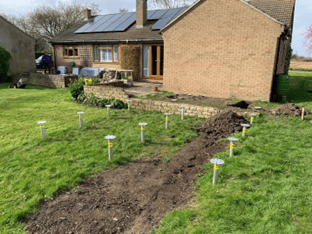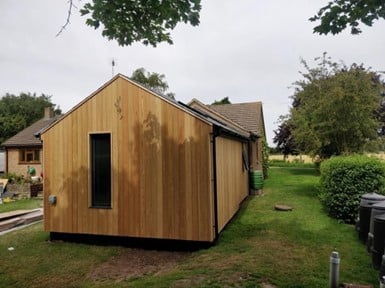Ground Screws – What Are They and How Do They Work?.

How we build is constantly evolving, both in the UK and around the world. In the UK, we have relied for many years on bricks, mortar, and concrete. These are tried and tested technologies, after all, concrete has been around for hundreds of years, but increasingly there are demands on us to change the way we build. When we visit other countries it is fascinating to see so many alternatives with the use of native materials to build structures, from timber and metal to mud and palm leaves, all without the use of concrete.
Whilst concrete is a very popular construction material choice in the UK and is the primary solution for building foundations, it is also a major CO2 contributor, and it is estimated that around 10% of global carbon dioxide is from cement/concrete production. With this in mind, innovative alternatives to concrete are becoming more popular. Ground screws, being an alternative to strip foundations, are one such alternative.
What are ground screws?
A ground screw is like a large version of an ordinary wood screw. Ground screws are based on the principle of pile foundations – one of the oldest and most reliable types of foundation. Ground screws are made from galvanised steel. They are a steel pipe with the thread welded on. This means they support horizontal and vertical loads in the ground and are installed with the help of a ground screw driver.
In the UK, ground screws are used for structures such as garden buildings (including garden rooms and offices), decking, fences, carports and larger constructions such as annexes, noise barriers and commercial solar panel arrays.

Figure 1: Ground screws placed in position
How are they installed and what are the benefits?
The installation process is very simple. A team of trained installers will attend the site and using calculations provided by a structural engineer, position and install the ground screws.
They provide the following benefits:
- They can be installed all year round and in any weather – installers claim that ground screws can be installed any time of the year, during spring, summer, autumn or winter, and in the sun, rain or snow.
- Overcome tricky locations – one of the key benefits of ground screws over conventional strip foundations is that they can be used where concrete can’t, capable of providing a strong, level base in
- hard-to-access and off-grid areas
- sloping and uneven ground
- Environmentally and archaeologically sensitive areas where minimal ground disturbance is essential
- They save time and money – ground screws take a fraction of the time to install, there is limited waste saving on costs of skips and sending materials to landfill, no necessity for waiting for concrete to set, preventing construction delays.
- They can be removed and recycled.
What is the future for Ground Screws?
In the UK, ground screws are beginning to change the way people think about concrete. While their use here is still limited, and domestically really only for garden buildings, the concept has been tried and tested around the world for some time, in particular in New Zealand where they use ground screws for the foundations of homes, replacing the use of concrete altogether.
Our business has witnessed a real boom over the last couple of years and we have found that since COVID-19 many more people are constructing a garden room/office. Once the humble upgraded garden shed, such structures can now be architecturally quite stunning and very well appointed. One such firm is Slope Spaces, a sister company to GS4u. Generally, these modern garden rooms are constructed using SIPs (structurally insulated panels) and are sometimes clad with a decorative finish. They provide extra space for working or recreation use. Using ground screws with these structures works perfectly instead of a concrete base.

Figure 2: Example of structure using ground screws
Will ground screws replace concrete in the construction of whole houses?
This is a difficult one to answer. In theory why not, since pile foundations are an accepted alternative to strip foundations.
However, if we consider ground screws in the context of alternative forms of construction perhaps the question is not so extreme. In the UK market, the use of SIPs is gathering momentum in mainstream construction as well as in extensions and garden rooms. They save on on-site construction costs and time, but SIP buildings are also generally more energy-efficient, stronger, quieter and more airtight. The benefits of lower energy bills and a significantly more comfortable and controllable indoor environment could not be more relevant as we see energy costs increasing. Therefore, it is our view that we will see increased use of SIPs over the coming years.
SIPs work perfectly with the ground screws, and it saves digging the footings and using concrete for foundations. The installation process does require calculations for loads etc. and is now accepted by forward-thinking architects and some Building Control officers up and down the country.
We are in talks with a company proposing complete modular homes using SIPs and we hope will be on-site to start the development of 30 homes in the autumn of 2022. By installing ground screws and replacing concrete foundations there will be quicker construction times with the associated cost savings as well as having less impact on the environment.
In summary, when inspecting properties with garden rooms now, do not assume concrete bases. In the very near future, we may need to look out for this type of foundation in whole homes.
Don’t’ get caught out.
